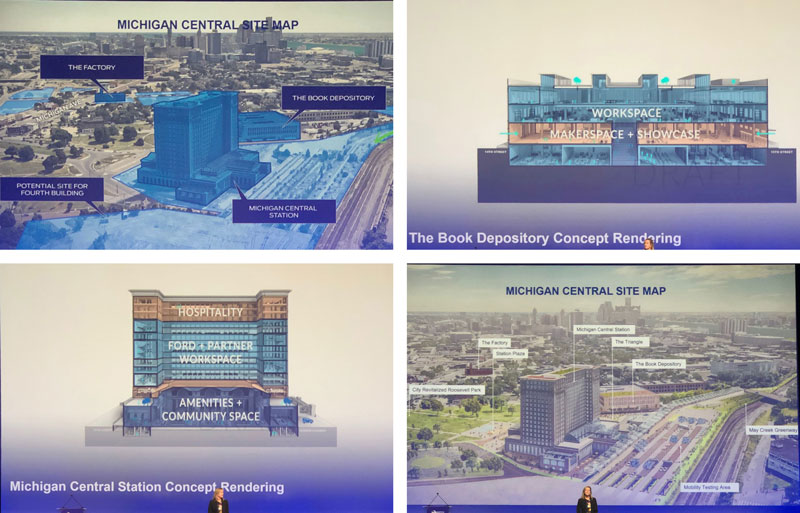
During a presentation today at the Detroit Regional Chamber’s Detroit Policy Conference at the MotorCity Casino Hotel, Mary Culler, development director for Ford’s Michigan Central Station redevelopment, announced that the $744-million project will include a mobility test area behind the iconic train depot.
Showing a new site plan, Ford or one of its partners may add a building west of the train station, though no details of what the structure would be used for were offered. In addition, Ford plans to add an outdoor park between the station and the former Book Depository building (originally Roosevelt Warehouse), to be called The Triangle, as well as a Station Plaza in front of the train depot. The plaza will adjoin Roosevelt Park, which the city of Detroit plans to renovate.
In addition, the May Creek Greenway, a tributary that dates to the founding of Detroit by the French in 1701, which later was filled in to accommodate rail lines, will be converted into a landscaped trail similar to the Dequindre Cut east of downtown Detroit. The Greenway will be completed by the Detroit Riverfront Conservancy and connect the Corktown community to the upcoming Ralph C. Wilson Jr. Centennial Park (west of the Riverfront Towers). The 22-acre park is scheduled to open in the next four year.
“We want to be a neighbor in Corktown and be inclusive to what’s already going on in the neighborhood,” says Culler, chief of staff to the Office of the Executive Chairman and president of the Ford Fund. “We remain on schedule, and it’s wonderful to see all the progress being made at the station.”
The 15-story train depot is set to reopen in late 2022 and offer stores, restaurants, and other retail offerings on the first floor, 11 floors of workspace for Ford workers and suppliers, and three floors of hospitality space at the top of the structure. Culler says the roof has been sealed and all of the water has been removed from the basement levels.
The Roosevelt Warehouse, which is scheduled to reopen next year, will include work space for Ford workers and its partners, a Maker Space and Showcase, along with a small theatre and other work spaces in the lower level. Nearby, Ford has renovated The Factory at the southwest corner of Michigan Avenue and Rosa Parks Blvd., where 250 workers are now working. A small museum where train station artifacts are displayed also is located in The Factory.
Culler says restoration of the depot includes cleaning, repairing, and replacing eight acres of masonry on the exterior of the building. To support the work, scaffolding now wraps around the west half of the 15-story tower.
A crane is on site and workers have started disassembling stone from around the Waiting Room entrance, which faces north toward Michigan Avenue, to allow craftsmen to fix the limestone façade and recreate missing and deteriorated ornate pieces — all part of Ford’s efforts to restore the Beaux-Arts building to its original grandeur.
To retain the historical integrity of the station, which first opened in 1913, the limestone blocks being used to replace the deteriorating stone on the façade will be sourced from the same Indiana quarry that provided the limestone during the original construction. Some of those early blocks of limestone still lie in a field a few feet from where they were first mined more than 100 years ago.
The Dark Hollow Quarry where the unique patterned limestone is found was officially closed in 1988. That grainy pattern fell out of favor with building projects in the 1920s. The remaining blocks of stone are now within a forest of 30-year-old trees. Local trades will construct a new haul road to access the stones and remove trees to get access to the historic material.
“It’s super exciting to use stone that was originally intended for the building,” says Richard Bardelli, Ford’s construction manager for the restoration project, who recently visited the Indiana quarry. “To come back to the same quarry where the first limestone was sourced from allows us not only an exact match in color and texture, but to maintain a strong connection to its storied past.”
In the early 1900s, the limestone was quarried by hand, with men using chisels and hammers; huge blocks of stone were transported by train to customers where it was carved on site. Today, the limestone is extracted and cut by machines, large blocks are moved by truck to regional fabricators and then shipped in its final shapes to the job site.
Michigan Central Station is one of many famous structures that has used Indiana limestone in its construction. Others include the Empire State Building, the National Cathedral, the new Yankee Stadium, the Pentagon and many state capitol buildings across the country.
Ford began the three-phase restoration project last year and plans to make the station the centerpiece of a new innovation hub in Corktown that will bring together new startups, established companies, urbanists, investors, innovators, and academic institutions to reimagine the future of transportation and make smarter, sustainable communities.
Before the stone is removed from Dark Hollow Quarry, workers will measure the blocks and look for other stone with the same pattern. Some might have to be extracted from the ground. The last time stone from the woods was used for another restoration project was eight years ago.
Beginning this winter, an estimated 8,000 cubic feet of the stone, approximately 300 blocks, will be shipped from the quarry in southern Indiana to Capital Stoneworks in Bridgeport, Mich. The company will take the raw stone and fabricate the replacement pieces needed for the train station.
The new stone will arrive in Detroit for installation in the spring 2020. Ford employs approximately 191,000 people worldwide.





